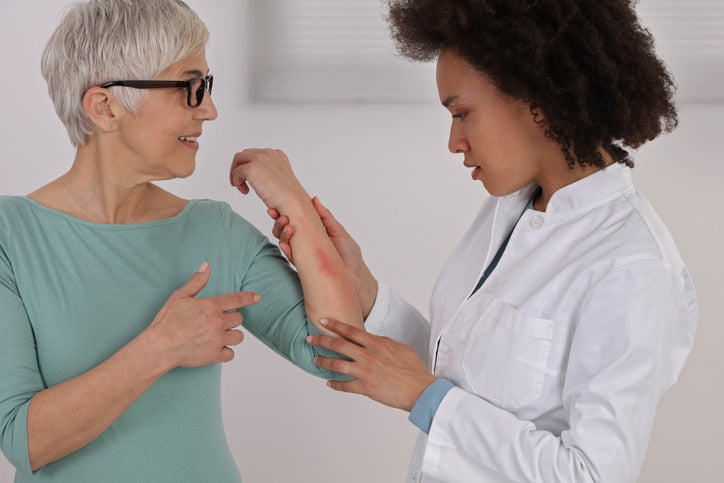Medically Reviewed by Dr. Lisa Hartford, MD
The colloquially used ‘Microcurrent’ term that is employed when referring to skin lifting and toning, is medically referred to Microcurrent therapy (MCT) and the technological nomenclature of which is Microcurrent Electrical Stimulation (MET). It uses electric currents similar to those produced by the body during tissue healing (usually following some form of stimulation of damage). It is an externally applied stimulation that penetrates down through the skin, and may be particularly beneficial where endogenous or natural healing processes of one’s body have failed.
Researchers studying bioelectricity and microcurrent therapy for tissue healing have found that microcurrent appears to play a significant role in the healing process, and beyond its stimulation potential can even promote healing in a range of bone and skin lesion issues.(1) There exist a range of current modalities and levels ranging from simple microcurrent, to Electrical Muscle Stimulation (EMS), all the way up to Transcutaneous electrical nerve stimulation (TENS). In the case of TENS, when measured in microampere range, is a thousand times stronger than MCT and is primarily a method of pain relief.(2)
While there exist studies that indicate that while microcurrent therapy is good for helping the skin heal following trauma, stimulation or injury, the studies that show exactly how that is achieved are still not very thorough on the topic. The theory behind all current therapies essentially, however, is that the nervous system is being leveraged by the current, resulting in strong muscle contractions being induced, ideally with minimum discomfort. This has been proven as far back as 1981, where in the Journal of Biomechanics, the researchers confirmed that electrical stimulation was successful in inducting muscle contractions.(3)
However, in the content that concerns the title of this article, we will now focus more on if microcurrent is truly beneficial to the goal of achieving tighter skin in older individuals who are concerned about sagging skin and loss of overall dermal volume. In this context it is noteworthy that where intentional and controlled skin stimulation is simultaneously exerted on the skin area being treated in tandem with the use of microcurrent, such as by also stimulation the skin with another higher-tier technology such as radiofrequency (RF), then positive skin tightening and lifting results and outcomes are more likely to be supported by research. As recent research shows, microcurrent can promote blood circulation, be modulated for transdermal drug delivery and promote skin wounds healing (as shown in the graphic illustration below):
 a Inflammatory phase after a cutaneous cut; hemostasis and invasion of inflammatory cells [53]. b Proliferative phase; organization of the thrombus, secretion of growth factors, synthesis of collagen III and the beginning of angiogenesis [53]. c Remodeling phase; regenerative processes fade and are followed by reorganization of the connective tissue and contractile response [53]. d Generation of skin wound electric fields. When wounded, the potential drives current flow through the newly formed low resistance pathway generating an electric field whose negative vector points toward the wound center at the lower portion of the epidermis and away from the wound on the upper portion below the stratum corneum [57]
a Inflammatory phase after a cutaneous cut; hemostasis and invasion of inflammatory cells [53]. b Proliferative phase; organization of the thrombus, secretion of growth factors, synthesis of collagen III and the beginning of angiogenesis [53]. c Remodeling phase; regenerative processes fade and are followed by reorganization of the connective tissue and contractile response [53]. d Generation of skin wound electric fields. When wounded, the potential drives current flow through the newly formed low resistance pathway generating an electric field whose negative vector points toward the wound center at the lower portion of the epidermis and away from the wound on the upper portion below the stratum corneum [57]
Therefore, if RF therapy is used on the skin using commercial in-clinic systems such as Morpheus8 or Thermage, or at-home RF solutions such as the Evenskyn Lumo, the intentional damage caused to the dermis to promote skin tightening through heating appears to benefit from the skin healing properties of microcurrent therapy. In this context it must also be noted that EMS, which generates muscle contraction by activating motor axons around the electrical stimulation location, having typically been employed as a postoperative rehabilitation technology and in sports medicine, offers a much higher level of stimulation compared to microcurrent, and is thus likely to prove more effective at skin lifting and toning than MCT by inducing higher levels of muscle stimulation and hypertrophy.(4)
Research further shows than EMS can promote changes in the composition of muscle fibers, promote glucose absorption, increase oxidase activity, and also stimulate the growth of type II fibers, which is dominated by the muscle strength, because of the axon size of type II fibers, for it is larger than I-type fiber and has lower resistance. The drawbacks are noted as the propensity of EMS to cause fatigue, thus devices such as the EvenSkyn Lumo specifically recommend limiting usage to 5 to 10 minutes of EMS use per session to allow the skin to not experience over-stimulation.(5)
Furthermore, many controlled clinical trials have also shown that in some specific diseases, EMS can significantly improve muscle strength and increase exercise capacity. Thus, in older individuals with aged skin and weaker muscle fibers in the periphery of their face and neck regions, the use of EMS proves highly effective for increasing the definition of said fibers, resulting in a more lifted and toned appearance.6
In conclusion, MCT and EMS both have been scientifically shown to be relatively safe and non-invasive noninvasive therapies for a number of medical applications, including the promotion of healing and improvement in muscle & skin tissues. However, research also shows that EMS is more powerful at stimulating muscle fibers compared to MCT. EMS is also shown to be a lot safer, while being effective compared to TENS therapy. Therefore, if one is seeking a solution to skin laxity issues, and if tighter and more toned skin is the goal, it may be recommended for the said person to consider EMS as part of their anti-aging but caution needs to be exercised as it is a more stronger modality than MCT and may cause the user discomfort. Modulating and controlling how much conduction medium is applied, such as a water-based conductive gel, may be a way to control the amount of sensation of EMS stimulation. Overall, EMS presents a very powerful and promising opportunity for aging skin toning and continued further research is needed to expound and uncover the various other reported benefits of the technology.
References- Poltawski, Leon, and Tim Watson. "Bioelectricity and microcurrent therapy for tissue healing–a narrative review." Physical Therapy Reviews 14.2 (2009): 104-114.
- Mercola, Joseph M., and Daniel L. Kirsch. "The basis for microcurrent electrical therapy in conventional medical practice." Journal of Advancement in medicine 8.2 (1995): 107-120.
- Moreno-Aranda, J., and A. Seireg. "Electrical parameters for over-the-skin muscle stimulation." Journal of biomechanics 14.9 (1981): 579-585.
- Xu, Xinkai, et al. "Effects of electrical stimulation on skin surface." Acta Mechanica Sinica (2021): 1-29.
- Brian, R.: The physiology of neuromuscular electrical stimulation. Pediatr. Phys. Therapy. 9, 96–102 (1997)
- Gerovasili, V., Stefanidis, K., Vitzilaios, K., et al.: Electrical muscle stimulation preserves the muscle mass of critically ill patients: a randomized study. Crit. Care 13, R161 (2009)









1 comment
Eliana
Does the Venus for under the eye have e and? I need to use ems under my eye in the festoon area to stimulate muscles after bad Botox , but i heard that the lumo may be too strong ?
Leave a comment
All comments are moderated before being published.
This site is protected by hCaptcha and the hCaptcha Privacy Policy and Terms of Service apply.